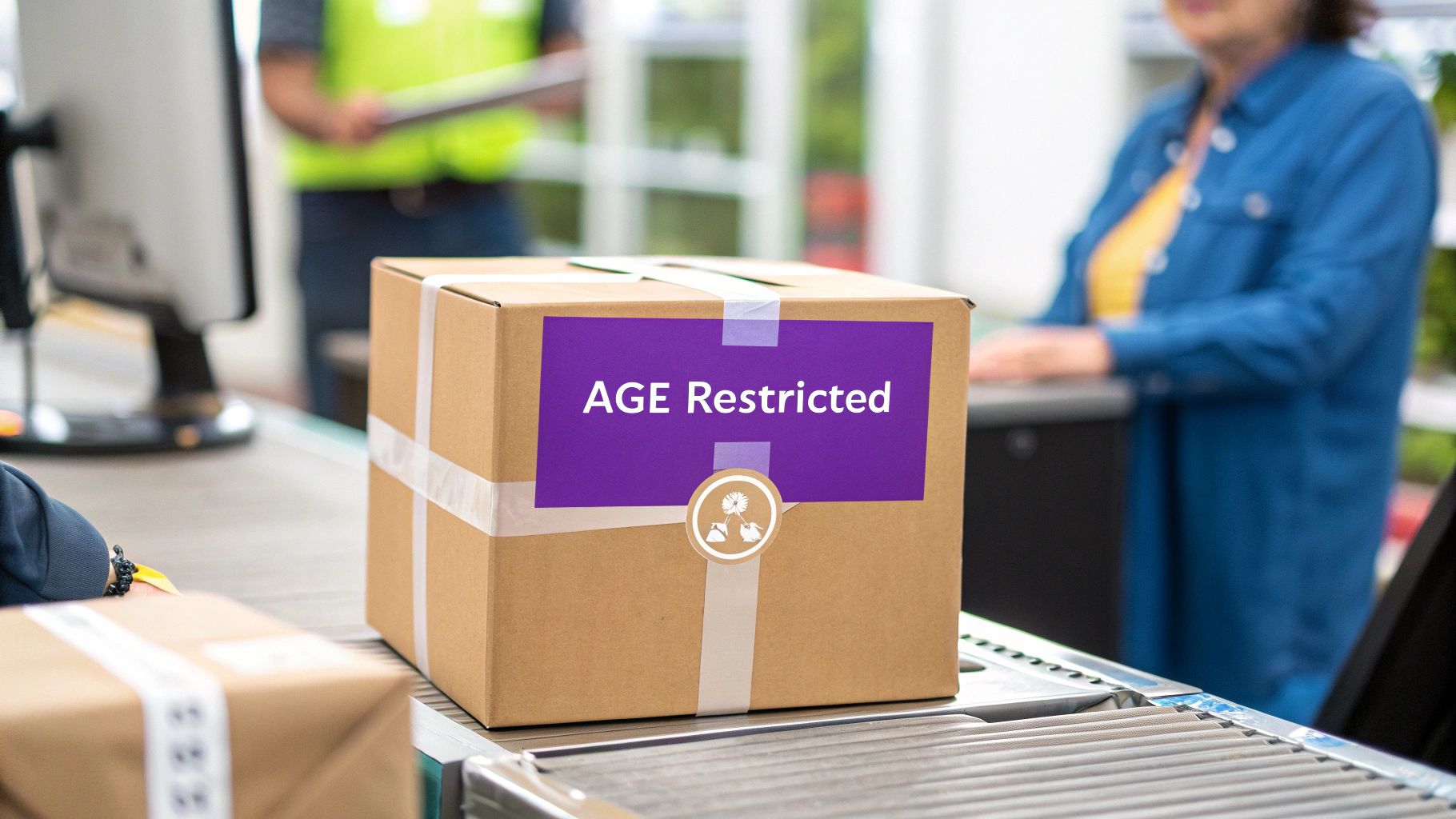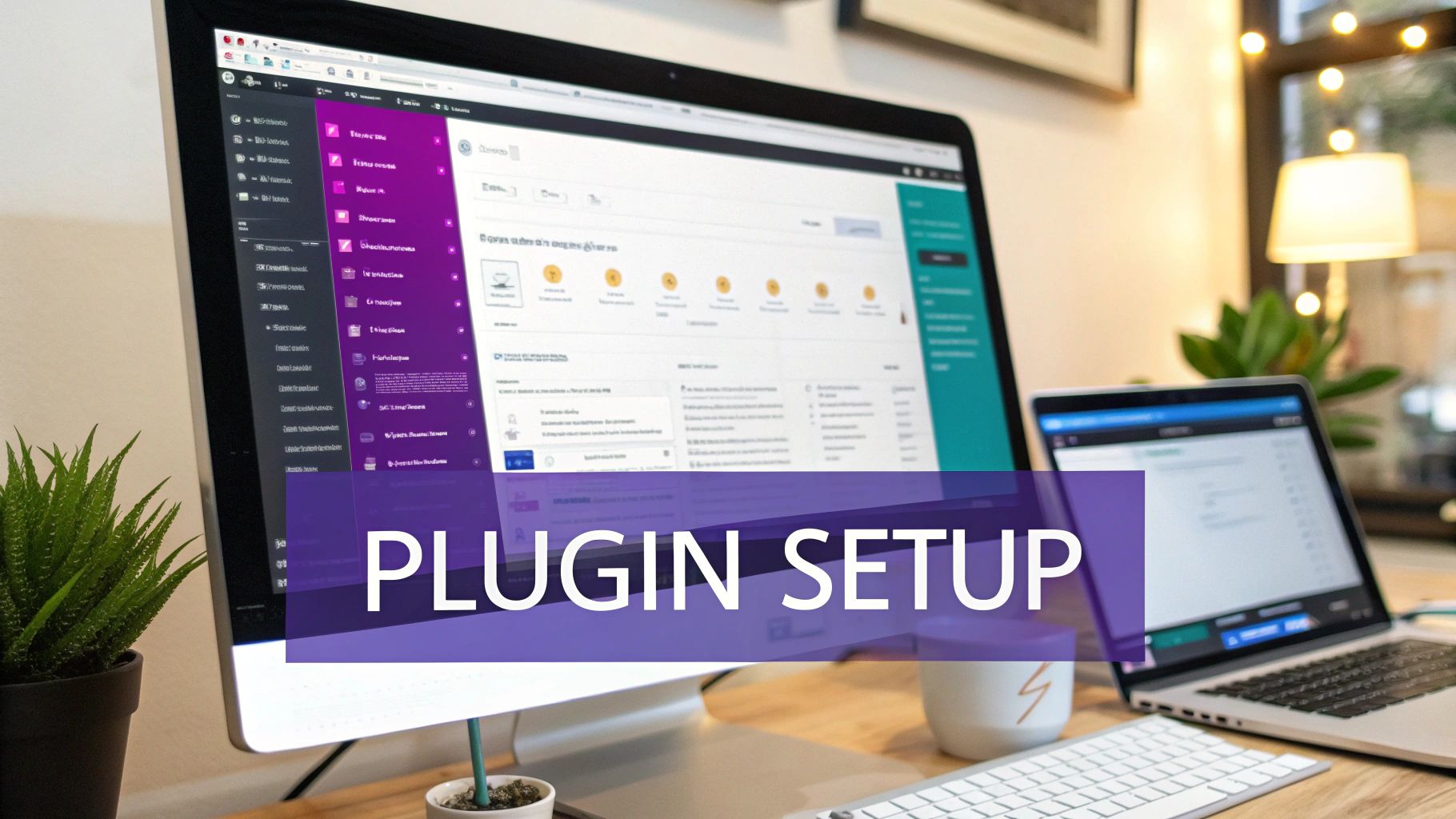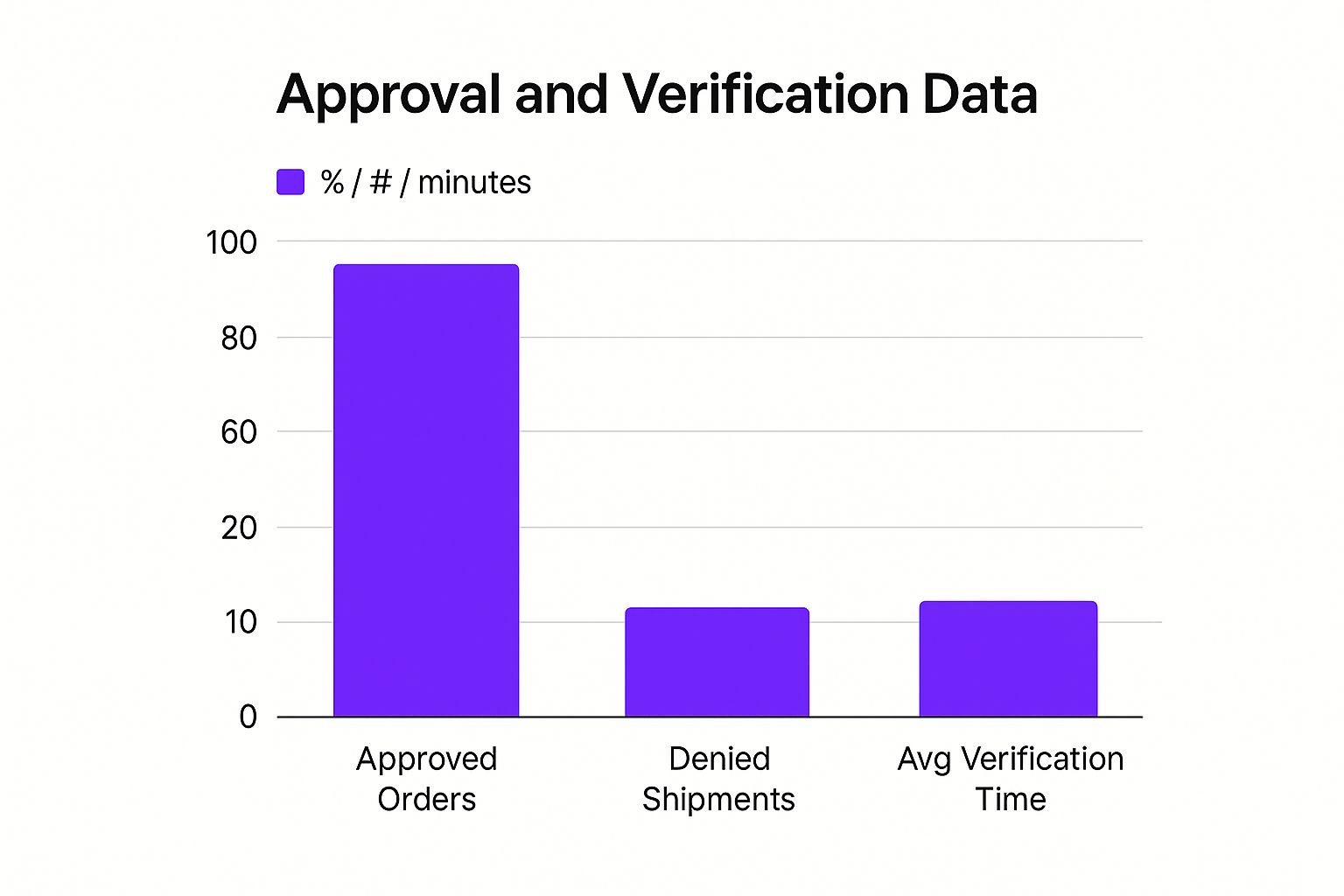
Age-Restricted Products: Setting Up Shipping Controls in WooCommerce
Learn how to set up shipping controls for age-restricted products in WooCommerce with our comprehensive guide. Ensure compliance and streamline your shipping process.
Cody Y.
Updated on Sep 1, 2025
Selling age-restricted products like alcohol, vape supplies, or firearms in WooCommerce takes more than just a simple age-gate popup. To do it right—and legally—you need robust shipping controls that can enforce your rules at checkout.
A basic popup only asks for a user's age. It can't stop an illegal shipment to a state or county where your products are banned. That's where dedicated shipping controls stop being a "nice-to-have" and become a business necessity.
Why Your Store Needs More Than an Age-Gate
Think of an age-gate popup as the first line of defense, but it's a surprisingly weak one. It runs on the honor system. More importantly, it does nothing to solve the complex web of state-specific shipping laws you're up against.
Selling regulated goods means navigating a maze of rules that can change from one zip code to the next. Failing to control exactly where your products can ship is a high-stakes gamble. You’re risking a lot more than just a disappointed customer; you’re facing real, tangible threats to your business.
The Real Risks of Weak Controls
Without a system that automatically blocks specific shipping destinations or methods, you're leaving your business wide open to some pretty severe consequences. Imagine shipping a case of wine to a customer in a "dry" county or sending vape products to a state where online sales are flat-out prohibited.
The fallout from a mistake like that is immediate and expensive:
- Returned Shipments: Carriers won't deliver illegal packages. They'll send them right back to you, and you'll be on the hook for the return shipping fees on top of refunding the customer.
- Hefty Fines: State and federal authorities—think the ATF for firearms or state liquor boards for alcohol—don't mess around. They impose significant financial penalties for compliance failures. A single slip-up can easily cost you thousands.
- Damaged Reputation: Every canceled order and failed delivery creates a terrible customer experience. That leads directly to negative reviews and a serious loss of trust.
A proactive approach with dedicated WooCommerce shipping controls isn't just another expense—it's a critical investment. It protects your compliance, your finances, and your reputation by turning your checkout into an automated legal checkpoint.
Moving from Verification to Enforcement
An age-gate asks, "Are you old enough?" A proper shipping control system confirms, "Can we legally ship this to you?"
That distinction is everything for a business selling age-restricted products. True enforcement means having smart rules in place that automatically check a customer's cart against their shipping address, then only show them the delivery options that are actually compliant. This is how you stop an illegal sale before it ever becomes a shipping label.
Setting the Stage in WooCommerce
Before you even think about installing a specialized plugin, you need to get your core WooCommerce setup right. It’s like prepping a surface before you paint—getting the foundation solid from the start makes every rule you build later on far more effective and less prone to headaches. The two most critical pieces of this groundwork are Shipping Classes and Shipping Zones.

First, we need to create a dedicated shipping class. Think of it as a special tag that lets you group all your regulated products together. By assigning items like ammunition, specific knives, or vape accessories to an "Age-Restricted" class, you can target them all at once with precision.
Creating Your Product Groupings
To get this done, head over to WooCommerce > Settings > Shipping > Shipping Classes. You’ll want to add a new class—something simple and clear like Age-Restricted is perfect. Once that’s saved, you can go into your individual products or use the bulk editor to assign this class to your entire inventory of regulated items.
This simple grouping is the absolute cornerstone of effective shipping controls. It tells your system, "Hey, anything with this label needs special handling at checkout." Without it, you’d be stuck creating rules for every single product one by one, which is a logistical nightmare nobody has time for.
Defining Your Geographic Boundaries
Next up are Shipping Zones. You'll find these under WooCommerce > Settings > Shipping > Shipping Zones. This is where you draw the lines on the map, defining exactly where you can and cannot ship. This goes way beyond just setting shipping rates for different countries; it’s about creating precise geographic boundaries that align with the law.
For instance, you could create a zone for the "Continental US" but then specifically exclude states like California or New York by simply not adding them to that zone's regions. You can get even more granular by defining zones with a specific list of allowed zip codes, which is absolutely crucial for navigating those tricky county-level or city-specific ordinances.
Key Takeaway: Properly configured shipping zones are your first line of defense. They prevent orders from being placed by customers in prohibited locations, stopping a non-compliant sale before it even begins.
The need for age verification in WooCommerce has become more critical than ever, with more jurisdictions legally mandating it for products like alcohol and tobacco. As of 2025, modern plugins allow store owners to restrict sales based on these legal age limits, often starting with a simple age confirmation gateway at the storefront. You can see how some businesses are tackling the challenges of WooCommerce alcohol shipping restrictions for more ideas.
Choosing and Installing Your Shipping Plugin
Alright, with your WooCommerce foundation set, it's time to bring in the muscle. This is where we add the enforcement engine—a specialized plugin that turns your shipping classes and zones into real-time decisions at checkout. The trick is finding a tool that’s powerful enough for complex rules but won’t bog down your store's performance.

For this walkthrough, we’ll be using Ship Restrict. It’s purpose-built for the kind of granular control you need when selling age-restricted products. If you’ve ever added a plugin to a WordPress site, the installation process will feel very familiar.
Finding and Activating the Plugin
First, head over to Plugins > Add New in your WordPress dashboard. You can search for "Ship Restrict" right there, or if you downloaded the plugin file directly, just upload it. Click "Install Now," and once that’s done, hit "Activate."
After activation, you should see a new menu item pop up in your dashboard, usually tucked under the main WooCommerce tab. This is your new command center for all things shipping control. It’s worth taking a minute to click around and get a feel for the interface now—it'll save you time later.
Creating Your First Essential Rule
Let’s jump right in and build the single most important rule for any store selling regulated goods. Think of this as your catch-all—it’s designed to stop standard shipping methods from ever being offered for your restricted items. Getting this right is the first critical step toward a compliant checkout.
The logic is simple: if a product from our "Age-Restricted" shipping class is in the cart, we need to hide any shipping options that aren't compliant.
Here’s how you’ll set up this foundational rule inside the plugin:
- Create a New Rule: Look for the option to add a new restriction. Give it a clear, descriptive name like "Block Standard Shipping for Restricted Items."
- Set the Condition: This is the "if" part of your logic. You'll want to base it on what's in the cart. Select the condition "Shipping Class" and then choose your Age-Restricted class from the list.
- Define the Action: Now for the "then" part. When that condition is met, you need to tell the system what to do. Choose an action like "Hide Shipping Methods" and then select all your standard options (e.g., USPS First Class, UPS Ground).
This one rule is your safety net. It ensures that no order containing a regulated product can slip through with a non-compliant shipping method, forcing the checkout process to rely only on the specialized, compliant options you'll define next.
Building Advanced Rules for Real-World Scenarios
Your basic restriction is a solid starting point, but real-world compliance for age-restricted products gets complicated fast. A single, site-wide rule just won't cut it when you're juggling state-specific laws, carrier requirements, and special customer groups. This is where you start layering conditions to create a smart, automated shipping system that thinks for you.
Let's walk through a common scenario. Say you sell products that legally require an Adult Signature Required service. You can build a rule that says, "If a product from the 'Age-Restricted' shipping class is in the cart, hide all shipping methods except for the specific 'Adult Signature' option." This simple but powerful rule forces compliance by making it the only choice at checkout.
Creating Location-Based and User-Specific Rules
Many products face outright shipping bans in certain jurisdictions. With a few clicks, you can create a rule that blocks all shipping methods if a customer's address is in a specific state, like New York, or even a list of prohibited zip codes. This stops an illegal sale dead in its tracks, long before you have to process a refund.
Another powerful technique is carving out exceptions for your trusted partners. For example, you can set up a rule that allows wholesale customers with a specific user role to access shipping methods that are otherwise hidden from the public. This gives your B2B clients a seamless purchasing experience without compromising your public-facing compliance. You can dig into all the different restriction types available to find the perfect fit for your store's unique needs.
Here's a quick look at how a basic setup compares to a more advanced, layered approach.
Comparison of Basic vs Advanced Shipping Rule Setups
| Scenario | Basic Rule (Single Restriction) | Advanced Rule (Layered Restrictions) |
|---|---|---|
| Selling Vape Products | Block all shipping methods except "Adult Signature Required" for all customers. Simple, but inflexible. | 1. Block all shipping to NY & CA. 2. For all other states, only show "Adult Signature Required." 3. Allow "Wholesale" user roles to see a bulk freight option. |
| Selling Knives | Block shipping for all products to a list of prohibited zip codes. Effective but doesn't handle different knife types. | 1. Block "Switchblade" category from shipping to specific states. 2. For "Kitchen Knife" category, allow all standard shipping. 3. For all other knives, require "Adult Signature." |
| B2B & B2C Alcohol Sales | A single rule prevents shipping to all non-licensed individuals, requiring manual checks for B2B orders. | 1. Block all shipping for guests/standard customers. 2. Allow users with the "Licensed Retailer" role to access all shipping methods. |
As you can see, layering a few rules provides much more granular control, automating decisions that you would otherwise have to make manually.

This data shows just how effective this kind of automation can be. By implementing smart, layered rules, one store was able to maintain an extremely high order approval rate while keeping manual verification times to a minimum. That's a direct boost to your operational efficiency.
Testing Your Setup and Communicating Clearly
Let's be blunt: a misconfigured shipping rule is a disaster waiting to happen. It can either block legitimate customers and kill your sales, or worse, let an illegal shipment slip through and land you in legal hot water. Before you flip the switch, it's absolutely critical to run a few real-world tests to make sure your age restrictions are working perfectly in WooCommerce.
You have to think like a customer. Go through your own store and try to break things. Simulate a few different shopping scenarios to find any potential cracks in your setup. Don't just test one product—try a mix of situations to be confident your rules are firing exactly as they should.
Your Practical Testing Checklist
A good test run covers the most common ways people will use your store. Here’s a quick checklist I run through to make sure everything is locked down:
- Restricted Item Only: Put a single age-restricted product in the cart. Try checking out with an address in an approved state. Then, do it again with an address in a state you've blocked.
- Mixed Cart Scenario: Now add both a restricted and a non-restricted item to the cart. Make sure the right shipping options show up and that the rules are being applied correctly to the entire order.
- Location Hopping: If you have rules for specific ZIP codes, test them! Try a few different ZIPs within the same state to verify your more granular rules are working.
- User Role Test: Did you set up exceptions for wholesale accounts? Great. Log in as a wholesale user and confirm that you can see the special shipping options you enabled for them.
Key Takeaway: A clear, helpful message turns a frustrating dead-end into a professional and transparent customer experience. Instead of just showing "No shipping options available," explain why.
Customizing Customer-Facing Messages
When a shipping option gets blocked, what the customer sees is just as important as the rule itself. A generic error message just creates confusion and leads directly to abandoned carts. You need to be crystal clear.
Most restriction plugins, including Ship Restrict, let you customize the message that appears when no shipping methods are available. Ditch the default text and write something specific and helpful.

For instance, a message like, "Sorry, we cannot ship this item to your state due to local laws," immediately tells the customer what's going on. It builds trust and shows that you’re a responsible seller who knows their stuff. This is especially crucial when you're dealing with more complex regulations, like those involved in managing hazmat shipping restrictions in WooCommerce.
As you start dialing in your shipping rules for age-restricted products, a few common questions always seem to pop up. Let's walk through the ones we hear most often.
What Happens If I Have Conflicting Shipping Rules?
It's a classic scenario: you have two rules that could apply to the same cart. So, which one wins? With a robust shipping plugin, the most restrictive rule wins.
Imagine you have a general rule allowing shipments to California. But then you create a more specific rule that blocks all shipments to a handful of zip codes in Los Angeles. If a customer tries to check out with an address in one of those blocked zip codes, the more specific block rule will always take precedence. No shipping options for them. This hierarchy is your safety net, ensuring you stay compliant.
Can I Allow Local Pickup for Age-Restricted Items?
Absolutely. In fact, it’s a smart move for serving your local community while staying compliant. You can easily set up a rule that hides all your standard shipping methods whenever an age-restricted item is in the cart, but you’d specifically exclude 'Local Pickup' from that restriction.
This setup is perfect because it lets customers buy online and pay, but it forces them to come into your store to get their product. That gives you the crucial opportunity to perform a mandatory, in-person ID check before handing anything over, keeping everything by the book.
Is It Better to Restrict by Shipping Class or Product Category?
For this kind of work, using a dedicated shipping class is almost always the more precise and flexible option. While you can restrict by product category, a shipping class gives you much more granular control over your inventory.
Think about it this way: maybe you sell collectible knives. One specific knife might require age verification, but a dozen other knives in the same category don't. Using a shipping class lets you group just the regulated items together for your rule, regardless of what category they live in. This keeps your rule management clean and dead-on accurate, which is essential if your store has a diverse product mix where broad category rules just won't cut it.
Ready to automate your shipping compliance and stop worrying about costly mistakes? Ship Restrict delivers the granular control you need to sell age-restricted products with confidence. Learn more and get started at https://shiprestrict.com.

Cody Yurk
Founder and Lead Developer of ShipRestrict, helping e-commerce businesses navigate complex shipping regulations for regulated products. Ecommerce store owner turned developer.